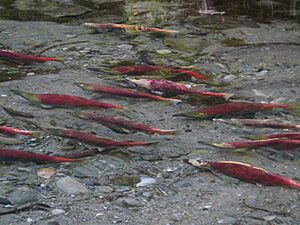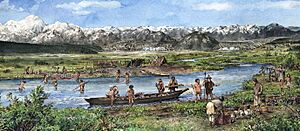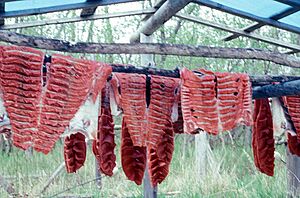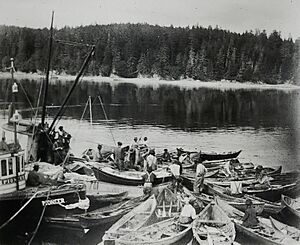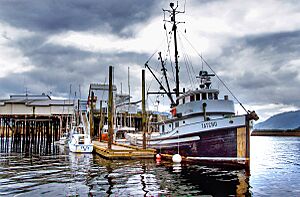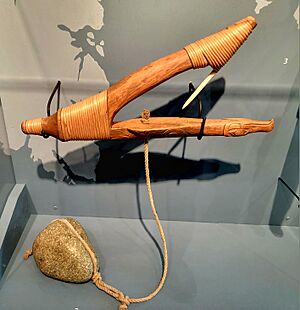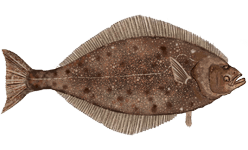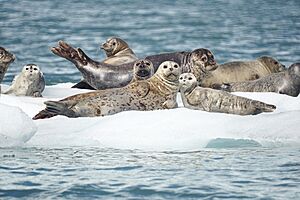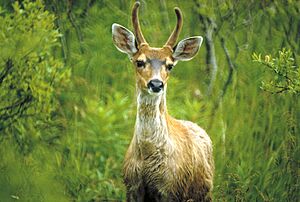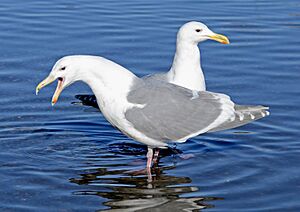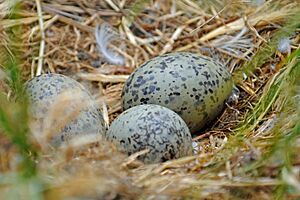Tlingit cuisine facts for kids
The Tlingit cuisine is the traditional food and drinks of the Tlingit people. They are an Indigenous group from Alaska, British Columbia, and the Yukon. Food is a very important part of Tlingit culture. Their land provides a lot of food.
A Tlingit saying is, "When the tide goes out the table is set." This means there is a lot of sea life on the beaches of Southeast Alaska. Most of this can be gathered for food. Another saying highlights how much food is available. It suggests that in the Tlingit homeland, it would be very difficult to go hungry. This shows how rich their environment is in food sources.
While eating only "beach food" could provide a healthy diet, the Tlingit value a varied diet. Eating only beach food was sometimes seen as a sign of hardship. For spiritual reasons and to enjoy different foods, the Tlingit gather many other resources. Salmon is the most important food. However, seal and other game animals are also very important.
Contents
- Eating Healthy: Tlingit Nutrition
- Ocean's Bounty: Beach Seafood
- Salmon: The Most Important Food
- Halibut: A Valued Catch
- Herring and Hooligan: Small but Mighty Fish
- Other Fish in the Diet
- Marine Mammals: Seals and Whales
- Game: Land Animals for Food
- Eggs: A Seasonal Treat
- Potatoes: A Local Crop
- See also
Eating Healthy: Tlingit Nutrition
The Tlingit diet makes sure people get all the vitamins and minerals they need. Protein is easy to find. Iodine comes from saltwater plants like seaweed. To get important things like calcium, vitamin D, vitamin A, and vitamin C, the Tlingit use almost all parts of the animals and plants they gather.
- Bones are used for soup stock, which provides calcium.
- Livers give them Vitamin A.
- Berries and plants, like wild celery and wild crab apples, provide Vitamin C.
- The nangoonberry, also called the Arctic raspberry, is a favorite. Its Tlingit name, Neigóon, means "jewel." Children help gather these tasty berries.
- Bone marrow offers iron and Vitamin D.
- Intestines and stomachs provide Vitamin E and B vitamins.
Today, many Tlingit also eat packaged foods and imported items. These include dairy products, grains, beef, pork, and chicken. In bigger towns, you can find common restaurant foods like pizza and Chinese food. Ice cream and SPAM are especially popular. Rice (koox) and pilot crackers (gháatl), have been staples for a long time.
Ocean's Bounty: Beach Seafood
The Tlingit gather many types of seafood from the beach. These include razor clams, clams, oysters, mussels, crabs, seaweed, and limpets. They usually cook these foods over an open fire or boil them. A large mollusk called the gumboot is considered a special treat.
Salmon: The Most Important Food
Salmon is the main food for the Tlingit. Traditionally, they caught salmon in many ways. A common method was using a fishing weir or trap. These traps helped guide fish upstream, making them easier to catch. This method required teamwork between men fishing and women cleaning the fish on shore.
Catching Salmon: Harvesting Methods
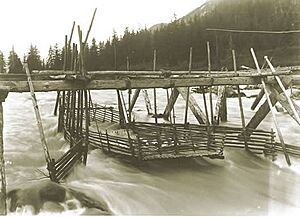
Tlingit built fish traps in different ways, depending on the river or stream. For smaller streams, they put rows of wooden stakes into the mud in the tidal zone. These stakes held a fence made of flexible branches. The fence was removed after the harvest, but the stakes stayed. Old sites show long rows of sharpened stakes in the gravel and mud.
Another trap for smaller streams used rocks piled into low walls. These walls were covered at high tide, and salmon swam over them. When the tide went out, adults and children threw rocks beyond the wall. This scared the fish into staying inside. Once the wall was exposed, men walked on it to spear the salmon. You can still see parts of these walls today, though they are not used for fishing anymore. Elders remember them being used in the early 1900s.
On larger rivers, the Tlingit built weirs that went across the whole river. Or they built them across channels where salmon were known to swim. These weirs had small gaps with platforms above them. Salmon had to pass through these gaps, making them easy targets for spearmen on the platforms.
Fishwheels became popular in the late 1800s, though they are not traditional. A fishwheel is a floating platform tied to a tree on the riverbank. It has two or four large baskets around an axle. The river's current spins the baskets, catching salmon. The baskets then dump the fish into a large container. Fishwheels are still used today in some places, like the Copper and Chilkat Rivers. They work without constant watching, so harvesters can check them a few times a day.
Traditional salmon trapping methods did not harm the salmon population. Once enough fish were caught in one area, the Tlingit moved to other spots. This allowed the remaining fish to lay eggs and ensure future harvests. This was different from commercial fish traps used later, which severely damaged salmon populations.
With gas motors, winter trolling became common. This provides fresh fish in cold months when people traditionally relied on stored fish. Trolling involves using heavy fishing poles with lures from a boat. The boat moves slowly in areas where salmon gather in winter. This method catches fewer fish, so it's mostly for fresh winter meals. Trolling is often a family activity on weekends.
Preparing and Storing Salmon
Salmon are roasted fresh over a fire, frozen, or dried and smoked to preserve them. All types of salmon are caught. The Tlingit language has different names for each type. Some species are better for smoking, canning, or baking. Today, common storage methods include vacuum-sealing raw fish and smoking it. Smoked fish is often canned afterward. Canning can be done at canneries or at home in jars.
Smoking is done over alder wood in smokehouses. These can be small ones near homes or larger ones at fishing sites. For home smoking, fish are kept on ice until brought home. For larger sites, all processing happens right there.
Tlingit still use some traditional methods alongside modern ones. Salmon are cleaned right after being caught. They are split down the back and hung on racks to dry for a few days. This removes slime and makes the meat easier to work with. Some people soak salmon in saltwater overnight before drying. Drying racks must be watched to keep bears and birds away.
Once dry, the fish are cut further and placed in a smokehouse. After smoking, the fillets are cut into strips. Traditionally, they were stored in bentwood boxes filled with seal oil. The oil protected the fish from mold and bacteria. It was a safe way to store fish and other foods for a long time.
During summer harvest, many people lived in their smokehouses. They moved walls and floors from their winter homes to summer frames. Other summer homes were simple shelters made of blankets and bark near the smokehouse. After Europeans arrived, canvas tents with wood stoves became popular. These summer homes were temporary and mainly for smoking fish.
Fishing for Families and Commerce
Many Tlingit work in Alaska's commercial salmon fishing industry. Alaskan law allows commercial fishermen to keep some of their catch for personal use. Today, many families rely on relatives in commercial fishing for most of their salmon. However, fishing for personal use is still common, especially during weekend family trips.
Halibut: A Valued Catch
Halibut was the second most important fish for the Tlingit. They ate fresh halibut and also dried it for winter and for trading. Instead of traps, they used special wooden halibut hooks. These hooks were designed to catch medium-sized halibut, letting smaller and very large breeding fish go.
Fishing for halibut was very important spiritually. It was seen as a respectful interaction with the halibut people. The wooden hooks had carvings of animals and shaman images. These were meant to show respect for the halibut.
Herring and Hooligan: Small but Mighty Fish
Herring (Clupea pallasii) and hooligan (Thaleichthys pacificus) are important foods. Various types of clams, crabs, and mussels are also gathered.
These are small fish that swim in huge groups to lay eggs near river mouths. Herring are traditionally caught with herring rakes. These are long poles with spikes. An experienced person can catch many fish with each swing. Nets are also used today. Herring are usually dried and smoked whole, similar to salmon. They can also be frozen. Traditionally, they were stored in seal oil, which was like a "Tlingit refrigerator." Today, they might be canned, salted, or frozen in vacuum-sealed bags.
Herring eggs are a special treat, sometimes called "Tlingit caviar." People place ribbon kelp or hemlock branches in areas where herring lay eggs. These are marked with a buoy. The herring lay their eggs on the kelp or branches. Once enough eggs are laid, the branches are removed and boiled on the beach. This is often a family or community event. Children often help stir the water. The cooked eggs can be salted, frozen, dried into cakes, or stored in seal oil.
Hooligan are caught like herring. However, they are valued more for their oil than their meat. Instead of smoking, they are usually boiled and mashed to extract their oil. The oil is skimmed off, strained, and stored. Hooligan oil was a valuable trade item. Today, hooligan are often vacuum-sealed and frozen.
When cooked, both herring and hooligan are usually served whole. Some people eat the entire fish. Others eat the meat and insides, leaving the bones. Eating the insides is common, unlike with salmon. They are often deep-fried or pan-fried. Baking is also common and more traditional. They can also be roasted over a fire on a stick, especially during harvests or at beach parties.
Other Fish in the Diet
The Tlingit also eat other fish like cod, bullhead, flounder, and shark. Halibut and lingcod were eaten often. Halibut were caught with spears, clubs, or special hooks.
Marine Mammals: Seals and Whales
Seals: A Long Tradition
Archaeologists have found that Tlingit people have hunted harbor seals with harpoons for at least 600 years. The Tlingit residents of Yakutat, Alaska continue to hunt seals for food. In 2015, they caught 345 seals. This number was lower than in 1996, showing how they adapt their diet when seal populations change.
Whales: A Special Case
Unlike many other groups on the North Pacific coast, the Tlingit generally do not hunt whales. One reason is spiritual. A large part of Tlingit society connects with killer whales or other whale species through clan symbols. These whales are seen as spiritual family members. Eating a whale would be like eating a family member.
Another reason is practical. A whale provides a huge amount of food that spoils quickly. Sharing such a large amount of food requires big, expensive feasts called potlatches. Whale hunting also needs many people to work together. This can create social obligations that are hard to manage. So, the Tlingit avoided whale hunting for social and economic reasons.
The Gulf Coast Tlingit near Yakutat are an exception. They sometimes hunt whales. Many Tlingit explain this is due to the influence of the Eyak and Alutiiq Eskimos further north. However, all Tlingit eat whales that wash up on the beach. They see this as a gift that should not be wasted. A story in the Raven Cycle tells how Raven was swallowed by a whale and ate it from the inside, causing it to wash ashore. This story helps explain why Tlingit eat beached whales. Since beached whales are rare in Southeast Alaska, whale meat is a very small part of the Tlingit diet.
Game: Land Animals for Food
Game animals are a big part of the traditional Tlingit diet. They provide most of the food that doesn't come from the sea. Major game animals hunted for food include Sitka deer, rabbit, mountain goat in the mountains, black bear and brown bear, beaver, and moose on the mainland.
Eggs: A Seasonal Treat
For hundreds of years, the Tlingit have gathered the eggs of the Glaucous-winged gull. They especially gather them from island nesting sites near what is now Glacier Bay National Park. This practice was made legal again in 2014. President Barack Obama signed the Huna Tlingit Traditional Gull Egg Use Act. This happened after studies showed that gathering eggs would not harm the gull populations.
A Tlingit elder said that gathering eggs in Glacier Bay was something the family looked forward to. It was like Easter, a joyful time for family and cousins. The egg-gathering season, from mid-May to mid-June, marked a change. It was when people moved from eating stored foods to actively fishing, hunting, and gathering fresh foods. The Tlingit calendar called this month the "Going to Get Eggs Moon."
Potatoes: A Local Crop
The Tlingit have grown a local type of potato for hundreds of years. This old variety is called "Maria's Tlingit potato." They plant it in sunny plots facing south. Potatoes are not originally from Southeast Alaska. Theories about how they arrived include through Russian traders. Tlingit stories also mention canoe trips as far south as South America, which might have brought potatoes back.
See also


